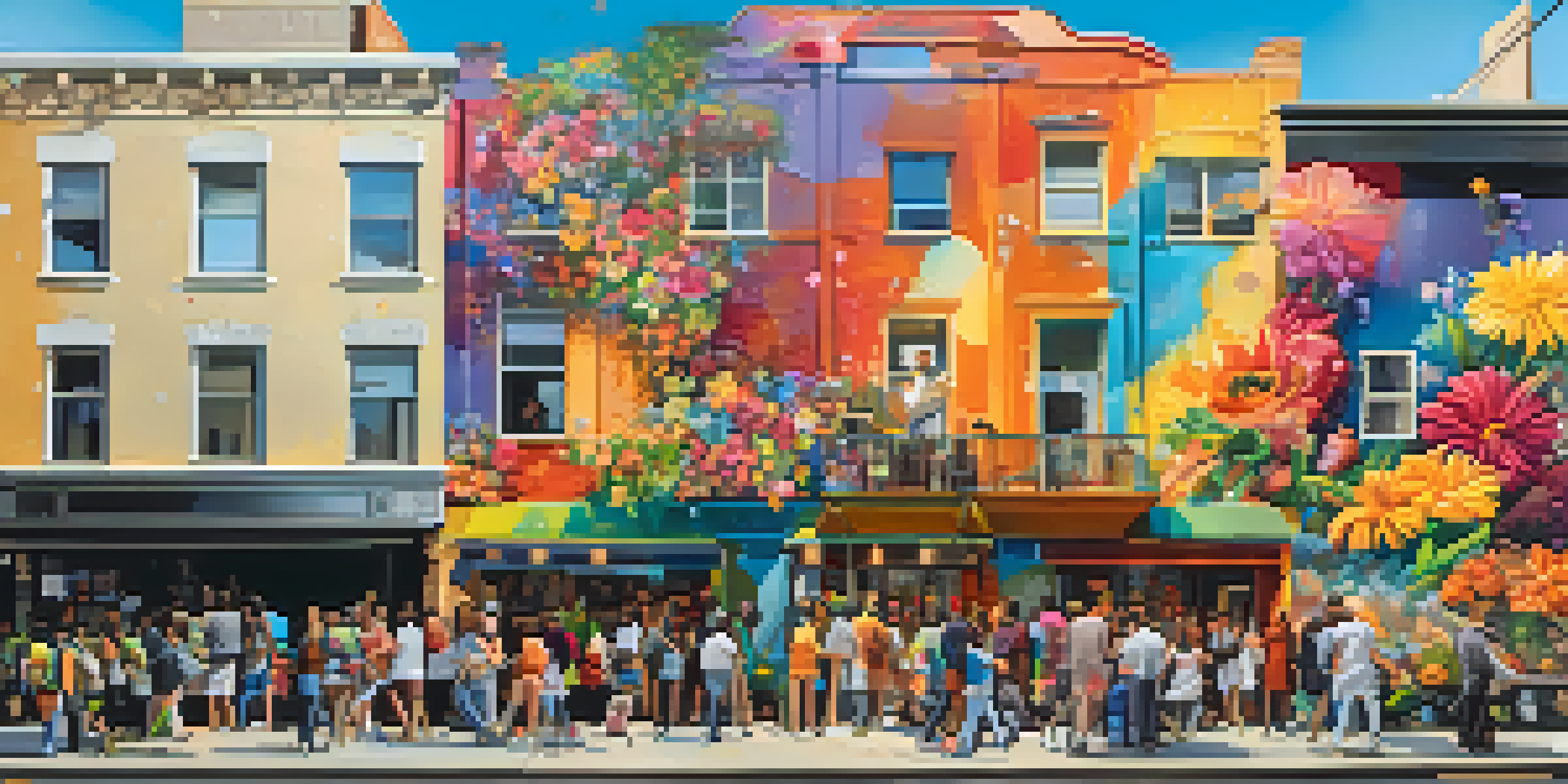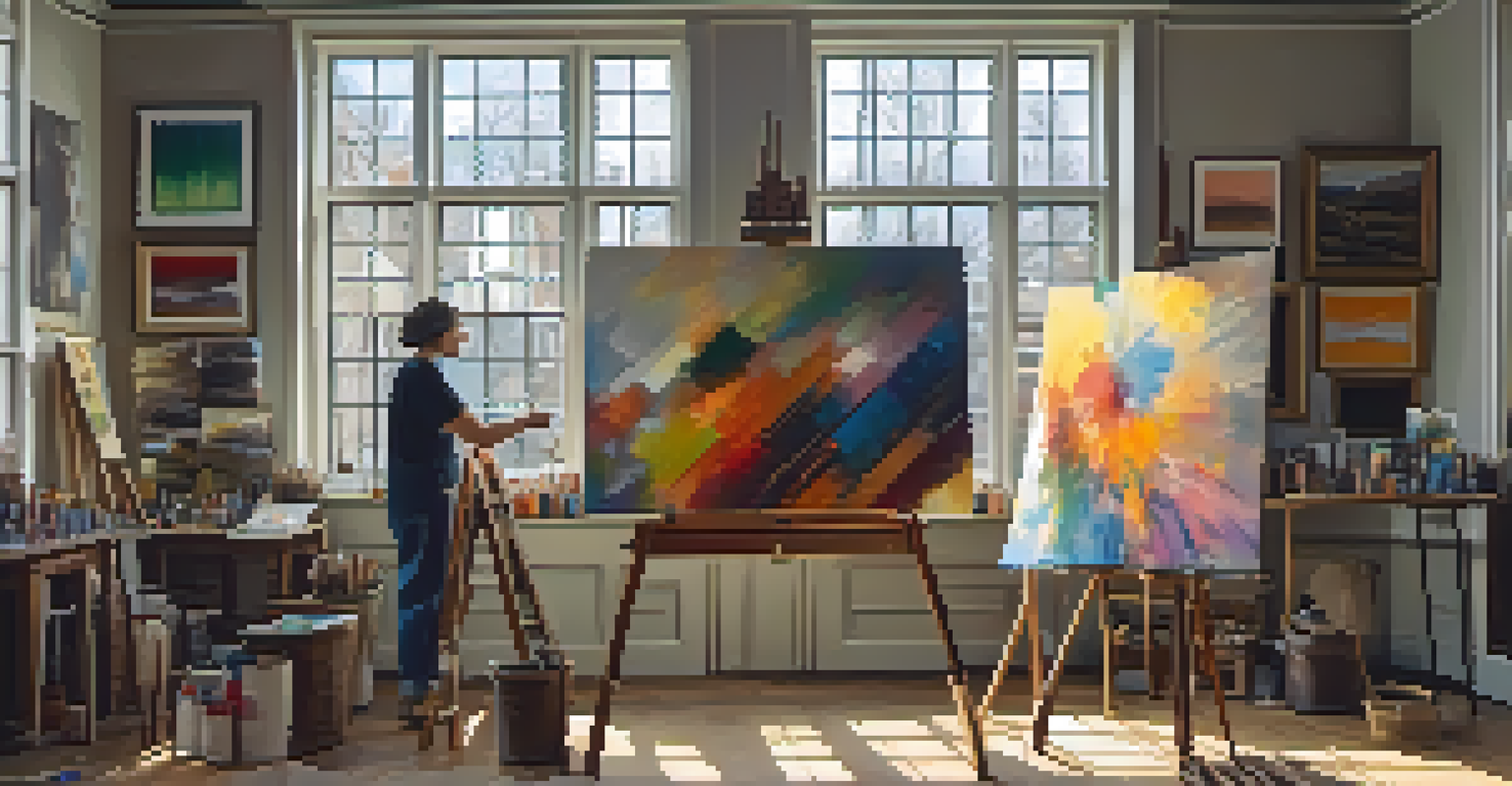Street Art vs. Traditional Art: Breaking Boundaries

Defining Street Art and Traditional Art: What Sets Them Apart?
Street art often includes graffiti, murals, and installations found in public spaces. It’s characterized by its vibrant colors, bold designs, and sometimes provocative messages. Traditional art, on the other hand, typically refers to forms like painting, sculpture, and drawing, often created for galleries or museums.
Art is not what you see, but what you make others see.
While street art is usually spontaneous and accessible, traditional art often follows established techniques and styles, aiming for permanence and recognition in formal settings. This difference in intention and audience perception creates an intriguing dynamic between the two forms. For example, a mural painted on a city wall can be seen by hundreds daily, while a classic oil painting might only be viewed in a museum.
Both forms have their own unique value and purpose, yet they also share common ground in their ability to provoke thought and evoke emotion. As we dive deeper into their distinctions, we start to uncover how they can complement and challenge one another.
Breaking Boundaries: The Evolution of Street Art
Street art has evolved significantly over the years, transitioning from vandalism to a respected art form. Artists like Banksy and Shepard Fairey have gained international acclaim, showcasing how street art can convey powerful messages about society and culture. These artists have transformed public spaces into thought-provoking galleries.

The rise of social media has also played a crucial role in this evolution, allowing street artists to share their work widely and connect with audiences globally. The act of creating art in public spaces now carries an added layer of social commentary, often addressing political issues or community struggles. This accessibility democratizes art, inviting everyone to engage with it.
Art Forms: Street vs. Traditional
Street art and traditional art differ in their accessibility and intention, with street art often being spontaneous and found in public spaces, while traditional art is typically created for galleries.
Moreover, street art often blurs the lines between artist and viewer, creating an interactive experience. Viewers are not just passive observers; they become part of the narrative, fostering a sense of community and dialogue that traditional art forms may not always achieve.
Traditional Art: Preserving Techniques and Cultural Heritage
Traditional art serves as a vital link to our cultural heritage, preserving techniques and historical narratives that define societies. From ancient sculptures to Renaissance paintings, these artworks tell stories of their time, reflecting the values and beliefs of their creators. They often require years of training to master, emphasizing the importance of skill and discipline.
Every artist dips his brush in his own soul, and paints his own nature into his pictures.
Moreover, traditional art is frequently displayed in galleries and museums, where it can be appreciated in a contemplative environment. This setting encourages viewers to reflect on the work's significance, fostering a deeper understanding of its context. It also provides a sense of permanence, allowing art to be cherished for generations.
However, the exclusivity of traditional art can sometimes alienate those who feel disconnected from the formal art world. This is where street art steps in, inviting a broader audience to appreciate creativity in a more accessible and relatable way.
Common Ground: The Intersection of Street and Traditional Art
Despite their differences, street art and traditional art often intersect in fascinating ways. Many street artists draw inspiration from classical techniques, incorporating elements like perspective and color theory into their vibrant murals. Similarly, traditional artists sometimes embrace street art aesthetics, creating mixed-media pieces that reflect contemporary culture.
Collaborations between street artists and traditional institutions have become increasingly common, leading to innovative projects that unite both worlds. For instance, some galleries host exhibitions featuring street artists, allowing them to showcase their work in a more formal setting. This fusion not only broadens the audience but also enriches the art community as a whole.
Cultural Reflections in Art
Both street art and traditional art serve as mirrors of society, with street art addressing contemporary issues and traditional art preserving cultural heritage.
Through these collaborations, both forms of art can expand their reach and relevance. By embracing each other’s strengths, they can create a dynamic dialogue that reflects the complexities of modern life and art's evolving role within it.
Cultural Impact: How Each Form Reflects Society
Art is a mirror of society, and both street art and traditional art reflect different facets of culture. Street art often reacts to current events, serving as a voice for marginalized communities and a platform for social justice. Its ephemeral nature captures the urgency of the moment, making it a powerful tool for activism.
In contrast, traditional art often seeks to preserve and interpret cultural heritage, showcasing the beauty and complexity of human experience. It tends to focus on themes that transcend time, such as love, conflict, and identity. This can create a sense of nostalgia and connection to our shared history.
While street art may be seen as a response to contemporary issues, traditional art often provides a foundational context. Together, they create a richer understanding of the world around us, illustrating how art can both challenge and celebrate the human experience.
Controversies and Critiques: The Debate Continues
The clash between street art and traditional art often sparks debates about legitimacy and value. Critics of street art may label it as vandalism, arguing that it defaces public spaces and undermines the seriousness of art. On the flip side, defenders highlight its role in urban revitalization and community engagement, emphasizing that art should be accessible to everyone.
Conversely, traditional art is often critiqued for its elitism, with some arguing that it can be disconnected from the realities of everyday life. This perception can create barriers for individuals who feel that traditional art isn't meant for them. However, many traditional artists are now actively seeking to engage wider audiences and bridge this gap.
Collaboration Shapes Future Art
The future of art lies in the blending of street and traditional styles, fostering innovative collaborations that reflect evolving societal values.
These controversies serve as a reminder of the evolving nature of art and its role in society. As both forms continue to challenge each other, they invite us to reconsider our perceptions and definitions of what art truly is.
The Future of Art: Blending Styles and Embracing Change
Looking ahead, the future of art lies in its ability to adapt and evolve. As society changes, so too do the forms and styles of artistic expression. We can expect to see even more collaborations between street and traditional artists, resulting in hybrid works that reflect a blend of techniques and messages.
Moreover, technology is playing a significant role in shaping the future of art. Digital platforms allow artists to reach wider audiences, and virtual reality is opening up new possibilities for immersive experiences. These innovations can help bridge the gap between traditional and street art, making both forms more accessible to diverse audiences.

Ultimately, the blending of styles and techniques creates an exciting landscape for the art world. As artists continue to break boundaries and experiment with new ideas, they remind us that art remains a vital, living expression of our humanity.